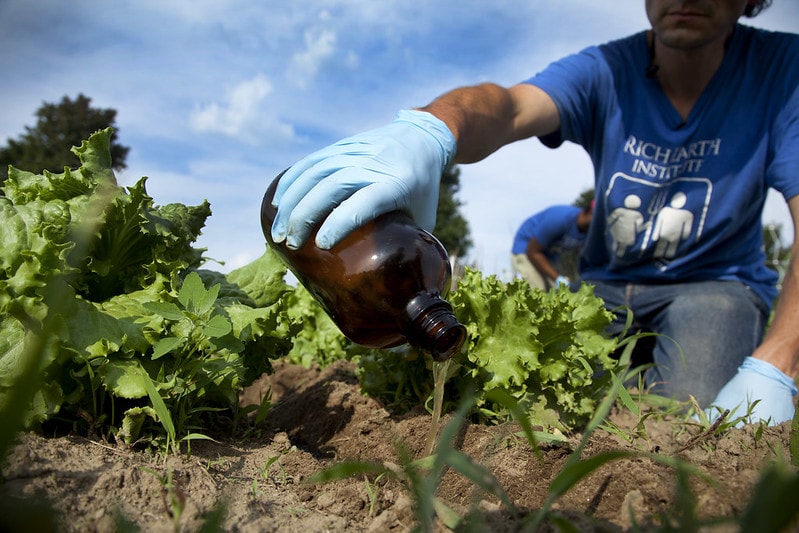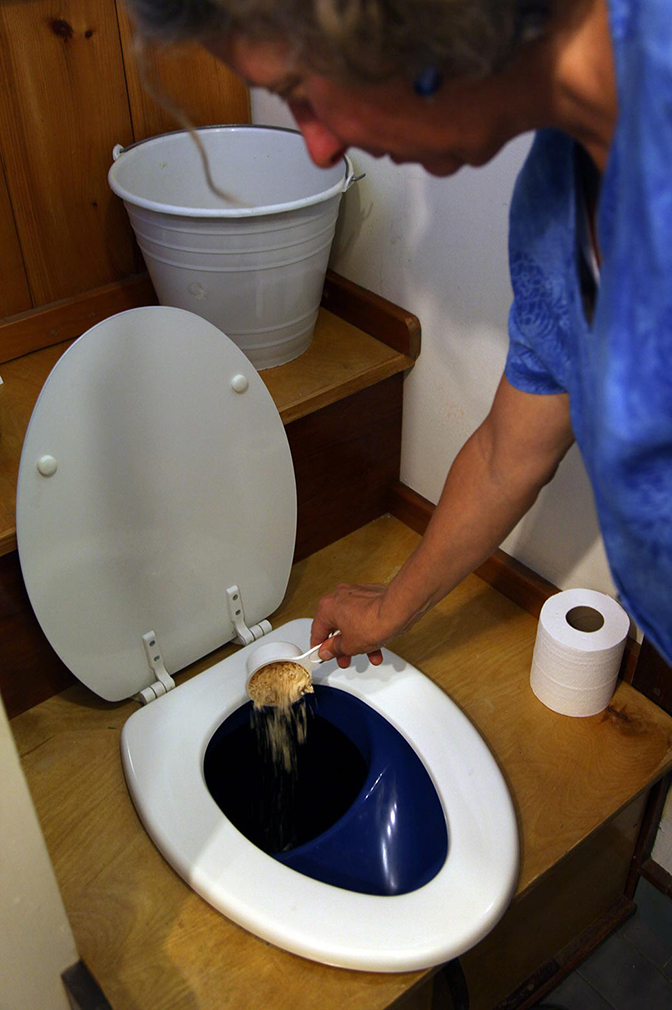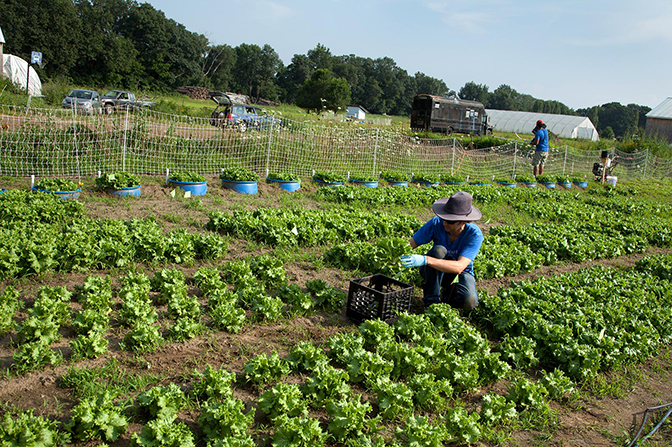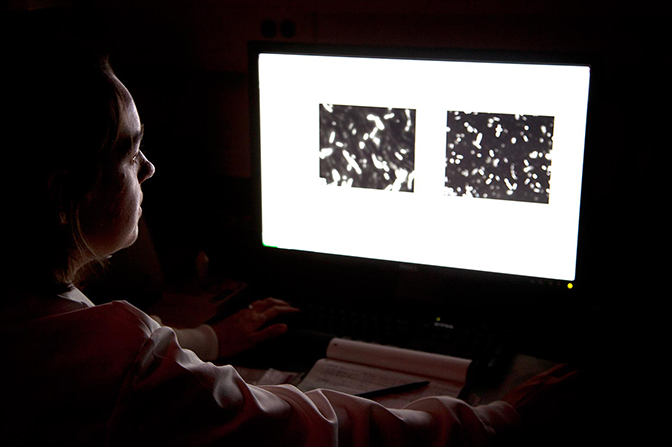
Peecycling: Beyond flush and forget
In the first large-scale pilot project of its kind in the nation, the researchers are testing whether they can safely make fertilizer for food crops out of disinfected human urine.

In the first large-scale pilot project of its kind in the nation, the researchers are testing whether they can safely make fertilizer for food crops out of disinfected human urine.
Sickness was thought to travel in stench in the mid-nineteenth century.
In the booming, Industrial Revolution-fueled cities of Britain, cesspools overflowed with the contents of chamber pots. Cholera, typhoid and flu rendered the life expectancy for a working-class man just 20 years in some towns.
Louis Pasteur hadn’t yet shown that germs cause disease. So no one knew that pathogens were passing through people and into the cesspools, and that the cesspools were leaking into drinking water wells. But they knew the outbreak-ridden, low-lying areas reeked.
“Before I got to the district, I was assailed by a most disagreeable smell; and it was clear to the sense that the air was full of most injurious malaria,” wrote architect Edwin Chadwick in an 1842 report.
Dying breadwinners were taxing the government aid system and Chadwick convinced authorities that better drainage might save lives. Enclose the sewers, he said. Rinse them regularly and make sure they all empty into the river, rather than into an unfortunate pile on a side street.
It helped. Yes, the new pipes held in the “bad air” thought to be causing illness. They also shielded the population from the real culprit – bacteria and viruses that traveled in excrement. Child mortality dropped. Fewer adults died, too.
The rivers were a different story. It would be more than 100 years before water quality policies would begin to clean them up.
But the “sanitary revolution” Chadwick helped mobilize is considered one of the most important technological developments of the past two centuries. When the prestigious British Medical Journal in 2007 asked readers to pick the biggest milestone during that time period, they named sanitation over breakthroughs like antibiotics, anesthesia and X-rays.
The flush toilet and wastewater treatment have lengthened lives by 20 years, writes Rose George in “The Big Necessity: the Unmentionable World of Human Waste and Why it Matters.” It’s no wonder that in a world where more than 2 billion people don’t have access to sanitation, many view this Western approach as ideal.
But a growing number of researchers point out that it’s not perfect. The “flush and forget” system, which has barely changed in the past century, demands tremendous amounts of water, energy and money. Despite that, it doesn’t return water to the ecosystem in the same condition it started. The “effluent” that treatment plants discharge is still studded with pollutants like chemicals from our shampoos and shaving cream, pharmaceuticals and their byproducts, and extra nutrients from the food we eat.
“I think we can do better,” said Krista Wigginton, assistant professor of civil and environmental engineering at the University of Michigan. She is leading a Water Environment Research Foundation project that takes a bold approach that could help curtail a host of the unintended consequences of how we handle human waste.
In the first large-scale pilot project of its kind in the nation, the researchers are testing whether they can safely make fertilizer for food crops out of disinfected human urine.
The project hinges on keeping waste streams separate, as our bodies do. Pee is mostly free of disease-causing germs. Those fester in feces. Liquid waste also carries the pharmaceutical byproducts and a majority of the nutrients – the nitrogen and phosphorus that loom as “one of the costliest and most challenging environmental problems we face,” according to an Environmental Protection Agency memo. Nutrients feed algae. Rampant algae blooms can lead to both “dead zones” that suffocate fish and toxins that could taint drinking water.
Across the country, most nutrient pollution tends to come from agriculture, or more precisely, rain washing over farms and into streams. But the dominant source varies by watershed and wastewater is a troublesome contributor in a lot of places.
In addition to reducing nutrients in water, recycling urine could streamline waste treatment. It could head off the emerging issue of pharmaceutical contamination, curb water use and even lessen the need to manufacture synthetic fertilizer.
“Currently, our agriculture and our wastewater treatment are open systems,” says Kim Nace, director of the Rich Earth Institute in Brattleboro, Vt., a study participant. “It’s not a closed circle. But it could be. It could all go around and around in a complete cycle.”

In a taupe stucco house next to a graveyard in Brattleboro, the Rich Earth Institute doubles as the home of Nace, her husband and one of their sons. We visited in August 2014, as the vegetables from the first test season were almost ready to harvest.
The institute has been advancing the use of human waste as a resource since 2011. In the project with Michigan, Nace and institute research director Abe Noe-Hays run the garden. But the institute’s heart is in its bathroom. Toilets led to its founding.
“Abe and I met many, many years ago,” Nace recalled. “Someone whispered in my ear at a potluck, ‘He’s into composting toilets.’ I kind of filed that in the back of my head and a lot of my life went by and then the right time came about.”
She had just gotten back from a stint as an elementary principal in India and was thinking of switching careers to work that involved sanitation. She called up Noe-Hays. Within months, they formed Rich Earth and decided to focus on turning urine into fertilizer.
Noe-Hays had been acquainted with waste more intimately than most since he was a teenager. His father had tasked him with taking care of the family’s composting toilet.
“It had odor issues. It didn’t compost very well and it wasn’t a very pleasant system to maintain,” he said. He won’t elaborate.
In college, he set out to improve it. Now it’s his business. One of his designs is in Nace’s bathroom. She regularly gives tours.
“This is a dry, urine-diverting composting toilet,” Nace said, gesturing toward the commode. It’s a varnished wooden bench with a conventional seat. On a shelf behind it sits a pail of wood shavings and a measuring cup.
“It’s very much like a regular toilet, except that there’s no water here.”
Nace lifted the lid. Something else is different. The bowl is divided to keep waste separate. A perforated shelf in the front catches urine and sends it down a pipe out to a tank in the side yard. (Men have to sit to pee.)
A chute in the back guides feces and toilet paper into a sealed container in the garage.
Instead of flushing after defecating, you pour down a cupful of wood shavings. This promotes composting.
Nace estimates that the toilet saves the family 12,000 gallons of water a year.
In the bathroom is the evidence that the system doesn’t stink, not even with the seat open. Underneath it all, in the garage, is the reason.
Noe-Hays showed off the Dr. Seussian arrangement of pipes he engineered to keep the system aerated to encourage composting and prevent odors.
From the toilet above, the foot-diameter shaft drops about five feet into a receptacle that resembles a city-issued trash can. Noe-Hays has retrofitted the lid, adding a tightly sealed hole where the chute connects. The lid clamps firmly.
A fan continuously sucks air down from the bathroom through the toilet and into the compost. The air exits the bin through another pipe that vents on the home’s roof. The ventilation ensures that the poop will get enough oxygen to turn into compost. And the fact that the container stays sealed means that over time, any pathogens present will die.
It takes the household of three about six months to fill a container. “Then you wheel the bin to the side, set it there for a year to rest and bring a new bin over in its place,” Noe-Hays said. “It’s a modular system.”
Though it might seem off-putting to store 18 months worth of feces in your garage, Noe-Hays says his approach requires less user involvement than other composting systems. And it works. At the photographer’s request, he carefully opened a bin that had been sitting for eight months.
Without inhaling, I squinted inside. It looked like mulch.
“It just smells a little bit like soil under the leaves in the forest,” Noe-Hays said, “which makes sense because that’s the same sort of thing.”
I took a shallow breath. He was right.

Behind the walls and under the streets of the United States today, the pipe network is vast. The American Society of Civil Engineers counts between 700,000 and 800,000 miles of sewer main. Compare that to just 164,000 miles of interstate highway.
The sewers connect to more than 14,500 wastewater treatment facilities that cost state and local governments $93 billion to operate in 2008. They take in about 400 gallons a day from the average family of four. Flushing the toilet accounts for 27 percent of that, the EPA estimates.
The Brattleboro Wastewater Treatment Facility is one of the smaller plants. It still handles 1.3 million gallons every day before letting it babble back into the Connecticut River on the edge of the famous Green Mountains.
Chief operator Bruce Lawrence showed us around the concrete campus on a hot, sunny day. We walked first past the brick headworks building, where the fresh sewage and stormwater come in. There, the sticks and large debris are removed. Beyond are the primary settling tanks – one-story, open-air pools ringed with white metal railings. Each has a staircase up to it and a life jacket hanging on top. On one, a sign reads: Caution: No Swimming.
I asked Lawrence about it. He smiled. A few years ago, one of the operators accidentally left a piece of metal grate out of the floor on one of the platforms.
“Another operator stepped there and, whoosh!” He pointed downward. “Went right in. He didn’t get hurt, so as sort of a joke, we made that sign.”
In the settling tanks, the solids sink and separate from the liquid. Then each is sent to a specialized reservoir where beneficial bacteria eat up the harmful ones. The liquid then goes to the shallow chlorine tank.
From here, you can hear the trickle of the clear liquid called effluent returning to the river. Most of it was never actual waste.
“We dilute our waste in drinking water. The whole notion is crazy, but it’s the way it’s been done for hundreds of years,” said Charles Bott, manager at the Hampton Roads Sanitation District in Virginia. The district is a partner in the U-M study.
Not only does this approach pollute more water than may be necessary, the single stream of solids, liquid and flushed water takes more energy and money to treat. To get anything out, you’ve got to tend to the whole slurry, even though the solids carry the vast majority of the harmful bacteria and viruses and the urine holds most of the nutrients and the pharmaceuticals we ingest.
Today, it’s so expensive to remove nutrients from wastewater that most treatment plants don’t. Because Hampton Roads is at the mouth of the Chesapeake Bay, one place where algal blooms have been an issue for a while, Bott’s district upgraded its technology several years ago to remove the nitrogen and phosphorus. The equipment ran about $400 million. Bott says it’ll cost more than that again to maintain over the next two decades.
States are working with the EPA to set nutrient limits and in 2015 about half will have them for at least some of their waterways. In addition to killing fish and deterring swimmers, the algal blooms nitrogen and phosphorus cause can be dangerous. They’re to blame for a doubling in nitrate drinking water violations over the past decade, the EPA says. And a bloom in Lake Erie was behind Toledo’s water crisis in 2014. The city had to turn off taps for three days.
Urine, which makes up just 1 percent of the waste flow, contains about 80 percent of the nitrogen and 45 percent of the phosphorus. These nutrients make algae grow in water for the same reason they make plants grow on land.

A pig crossed in front of the car as we pulled up the long dirt driveway at the homestead that hosts the test garden.
To the right, Queen Anne’s lace and wildflowers surrounded the plot where 1,000 heads of curly green leaf lettuce and carrot tops grew. Noe-Hays stepped over the mesh fence that keeps the animals out.
“These lettuces are getting pretty big!” he said.
Some of the plants received different formulations of liquid urine fertilizer. Some got chemical fertilizer. Some got no fertilizer at all. Those are the only ones that looked smaller.
The researchers also grew a subset in barrels called lysimeters, designed to catch the rain that filtered through the urine-fertilized soil and enable them to study the fate of the nutrients and pharmaceuticals in the environment as well as in the plants.
Noe-Hays and a colleague pumped water samples out of the bottom of the 20 barrels. Then Noe-Hays added an extra “side dressing” of urine to a few lettuces. A couple inches from their bases, he dug a trough. He slowly poured the golden liquid along it, and covered up the channel with his glove-covered hand.
Fertilizing with urine has never been mainstream in the U.S., but Noe-Hays and Nace say it’s widespread among hobbyist gardeners. It’s more common in other countries, like Japan and Sweden. The World Health Organization distributes guidelines that OK its use on home gardens, provided you harvest at least a month after the last time you fertilize.
At the Rich Earth Institute, they picked the greens in early August and the carrots in October. They peeled the carrots and grated them. They broke apart the lettuce heads. And they sent samples of each to labs at universities in Michigan and New York.

Use cryogenic gloves to avoid burning hands. So says a sign on the ultrafreezer in the Environmental Biotechnology Laboratory at U-M. It’s frosty inside, where temps dip to -112 Fahrenheit. Test tubes of frozen urine share a rack with metal bins of sandwich bags full of carrot shavings and salad leaves.
Rebecca Lahr, a postdoctoral researcher, let a Ziploc of carrots thaw before leading a round of test experiments. The results were unofficial. During the 2014 pilot cycle, researchers worked out the methods they’ll use over the next two years.
They also “characterized the heck” out of the urine that was being applied to the fields – pee they gathered in special Porta-Potties they brought to public events in Vermont. They know how much nitrogen, phosphorus and potassium the fresh urine contains. They know what organisms tended to be swimming in it when it was new and after it set for a while or was heated. They saw E. coli in at least one fresh batch, for example. But a month later, it was gone. As urine ages, its chemical composition can sanitize it.
A lot of their work, they did under a hood meant to vent hazardous vapors outside. It’s not that the urine was hazardous.
“Once you start smelling it, you can’t stop,” Lahr said. “You can smell the ammonia, which helps to deactivate pathogens as the sample ages.”
As part of the project, the researchers will eventually use urine to make pellets of a solid fertilizer called struvite. It’s a mineral that sometimes forms in the body and can cause kidney stones. Lahr said it doesn’t have that ammonia odor.
Saloni Dagli, a junior studying environmental engineering, arrived at the lab to work with the carrots. She portioned them into tiny test tubes about as wide as her pinky. It was a painstaking process, like all analytical chemistry. The carrots tended to stick to each other.
“It’s hard to balance the tiny pieces,” she said.
Dagli finished ten tubes. Then she added to each a precise sprinkling of glass beads that would pulverize the contents, a measure of E. coli to serve as a tracer, and about 1/25th of a teaspoon of a solution that kept the samples at the proper pH. Then she blended them into thimble-sized smoothies.
The researchers spun the smoothies in a centrifuge to separate the cell debris from the DNA that was once inside them. They examined that DNA to make sure the tracer E. coli genetic code came through, and that their approach didn’t somehow destroy it.
Over the next two seasons, they’ll use methods similar to this to study the fate of bacteria and viruses in the veggies from Vermont. With other procedures, they’ll peer deep into samples of urine, struvite pebbles, soil and lysimeter water. They will hunt for bacteria, viruses and antibiotic-resistant genes – common in urinary tract infections. Not only will they track them all through the cycle, they’ll evaluate different ways of eliminating any pathogens they do find.
“A few questions we have are: What contaminants are applied onto the fields with the fertilizer, where do they go, and how can we get rid of the concerning contaminants before they are applied?” Lahr said.
At the University at Buffalo, researchers are probing for pharmaceuticals. Led by Diana Aga, a professor of analytical chemistry, they’re measuring concentrations of more than 20 medications in fresh urine, aged urine, struvite, soil, rainwater and vegetables.
They’ll look for the active ingredients in Tylenol and Advil, as well as the antibiotic sulfamethoxazole, sold under the brand name Bactrim, and the anti-seizure drug carbamazepine. Caffeine also makes the list.
In the pilot season, Aga’s team found high levels of the compounds in fresh urine and traces in the lettuce leaves. Neither finding was a shock. Other teams have had similar results. Going forward, the team will examine different parts of the plants. Maybe just the outer lettuce leaves suck up pharmaceuticals, or maybe just the part of the carrot that we peel off anyway.
“The amount we detected is very low,” Aga said. “We are planning to see what we can do to reduce the concentration of pharmaceuticals before we apply the urine. If we let the urine sit for six months, maybe the pharmaceuticals will degrade, and we won’t see plant uptake.”
They’ll study various storage conditions and see what effects sunlight and heat have, for example.
Smaller studies on where pathogens and pharmaceuticals in fertilizers end up have been done here in the U.S. and abroad, but they’ve focused on specific organisms or substances, said U-M’s Wigginton.
“Our project is going to give a much more complete picture of the contaminants,” she said.
If they do find that urine is safe to use, what then? There will still be obstacles.
“Here in the U.S., we can do all this research but we’re going to come up against this wall of infrastructure,” Wigginton said. She’s speaking of those miles of sewer lines.
Perhaps urine diversion could catch on in new construction, in apartment buildings or dorms, though. Or individual homes in places like Cape Cod, where regulators and residents alike are desperate to lower nutrient loads. Separating waste streams might be most feasible in parts of the world that don’t have sewer networks yet. In any case, Wigginton hopes the project can give some guidance to regulators everywhere.
“I think we’ll eventually go this direction, but there’s a whole stigma associated with it and we’ll have to get over that,” she said.
I asked her how.
“I don’t know the answer to that,” Wigginton said, then paused. “I’d say educating people, but sometimes you find that educating people doesn’t solve the problem. I think that people have to understand that in a way, we’re already doing this. They’re very comfortable with us putting the waste into the stream and then picking it up again later.
“But what if we could just take out the urine from the start?”
While Lawrence, the Brattleboro wastewater treatment operator, would appreciate some waste taken out of his stream, he isn’t sold.
“They’ve got a noble effort going,” he said. “But I think they’ve got a lot of work ahead of them, mostly to get public acceptance. The normal, if you will, public person will say: ‘Those carrots were grown with pee for fertilizer? No way!’”

On the back deck at Nace’s place, we were eating a dinner of grilled tortillas with beans, cheese and salad when we heard someone pull up the driveway. It was Nace’s neighbor, Abby Mnookin, lugging a five-gallon jug of amber liquid.
She came to visit the Urine Depot – a spot nearby where more than 100 local volunteers who collect their urine for Rich Earth can pump it into a tarp-covered tank about the size of a washing machine. (The stuff in the tank, like the stuff from the institute’s bathroom, is for other projects – not Michigan’s.)
After she emptied the jug, she joined us to chat. Mnookin is a coordinator of the town’s time bank – a bartering system through which she has, for example, babysat for one person in exchange for dog training from another. She’s used to new currencies.
“On the one hand, what Rich Earth is doing is revolutionary,” she said, “and on the other hand it feels so intuitive – just not to throw away this resource.”
She’s had some explaining to do for family and friends who see the “nun’s cap” toilet insert in her bathroom. But in her case, an explanation is all it took to convince others to become donors themselves – to break the taboo.
“We’ve been trained to feel shame around what comes out of our body,” Nace said. “While we need to have a healthy sense of fear about these pathogens, and we need to wash our hands and understand that we can get sick if we don’t manage things properly, we need to think about waste and talk about it.”
And some day soon, she hopes we will reap its vegetables.